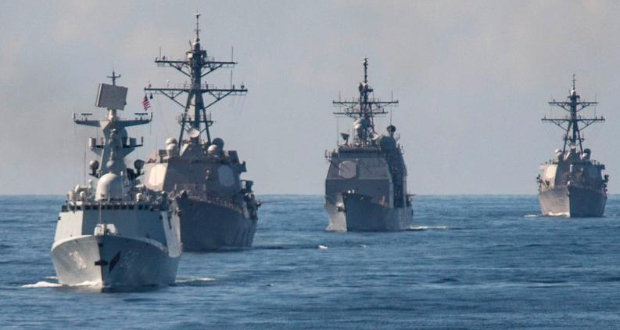Publicité
Indian Ocean
How the roots of the India-China competition go back to the 1990s
Par
Partager cet article
Indian Ocean
How the roots of the India-China competition go back to the 1990s

The competition between India and China in the South-western Indian Ocean has obliged states in the region, Mauritius included, to take up a delicate balancing act between New Delhi and Beijing. Here is why the roots of this competition lie in events dating from the 1990s.
New Delhi at independence
Since at least 2005, regional states have been plunged into a competition between China and India in the South-western Indian Ocean getting states in the region, such as Mauritius, to engage in a delicate balancing act between the two. With both New Delhi and Beijing looking to frame the debate in ways that suit themselves, it’s important to understand how the current competition between the two actually has long roots.
The importance of the Indian Ocean in Indian strategic thought started early on. The historical experience of European traders coming by sea and ending up dominating the Indian sub-continent led many eminent Indian thinkers to emphasize the importance of the Indian Ocean where India has 7,500 kilometres of coastline. Its most eminent naval strategist K.M Pannikar wrote in 1945 that “a true appreciation of Indian historical forces will show beyond doubt, that whoever controls the Indian Ocean has India at its mercy”. He proposed setting up a ’steel ring’ of military bases in Singapore, Mauritius, Yemen and Sri Lanka to safeguard the region for New Delhi and to make sure that it “must therefore remain truly Indian”.
There were two problems confronting independent India; the first was its poverty, and the second was that both of its most bitter enemies – China and Pakistan – were both land-based powers. The result was that for decades, India was content with splurging on its army while ignoring its navy.
In the meantime , Pannikar and post-colonial Indian leadership favoured the next best option, leaving the Indian Ocean as a ’British lake’ where London would lend stability to the seas that would eventually become a “reserved sphere of AngloIndian influence” jointly administered by India, UK, Australia and South Africa (today’s QUAD is not really as new an idea as it seems, albeit with a different membership).
This idea lasted till 1968 when then-British prime minister Harold Wilson announced the UK’s withdrawal from military bases in Malaysia, Singapore, the Persian Gulf and Maldives and, fearful of the resulting vacuum being filled by the Soviet Union, started bringing in the US, specifically into Diego Garcia. In 1971, the US supported Pakistan in its bid to keep Bangladesh from splitting away and sent a carrier battle group into the Bay of Bengal to signal a warning to New Delhi against escalating the war.
The exit of London and the entry of the US turned opinion in New Delhi; while previously it saw the UK and the BIOT as a stabilizing influence, now it perceived it as a threat. It reacted in two ways; on the one hand, pressuring Mauritius to raise the issue of Diego Garcia and on the other, lending its support to the declaration of the Indian Ocean as a zone of peace closed to foreign militaries (although pushing back against efforts to also declare it a nuclear-free zone given Indian ambitions to become a nuclear power). This continued until the mid-1980s when India started coming closer to the US with Washinton D.C. tacitly backing Indian interventions in Sri Lanka in 1987 and Maldives in 1988.

The rise of India
The 1990s really saw New Delhi able to come into its own in the region. For one thing, starting in 1984, the Soviet Union began drawing down its Indian Ocean fleet finally withdrawing from the Red Sea, the Persian Gulf and the Indian Ocean in February 1991, abandoning its naval bases in Ethiopia’s Dahlak Island and Yemen’s Socotra Island. For India, this opened up new space for the expansion of its own influence in the region, including in places like Seychelles, which until then relied on Moscow for its security. The Soviets used to park 250 of its marines aboard a ship in Port Victoria – dubbed the ’babysitter’ – each time Seychelles’ President Albert René travelled abroad to prevent coups.
On the other hand, New Delhi’s economic rise following economic liberalization in the 1990s suddenly put at its disposal the means with which to create its own large, modern navy capable of realizing its pent-up ambition for the region. Under its Maritime Capabilities Perspective Plan, the Indian navy plans to have 200 ships and 500 aircraft by 2027. This new confidence saw India taking the lead in setting up regional organizations such as the Indian Ocean Rim Association in 1997, and the Indian Ocean Naval Symposium in 2008, bringing together the maritime security agencies of 24 Indian Ocean states.
For states like Mauritius this saw an expanded Indian security footprint starting in the late 1990s when New Delhi first started approaching Port Louis to set up a facility on Agalega; it finally got it in 2015. Or setting up a web of coastal radar systems in states in the region starting in 1996, or the Indian navy carrying out maritime patrols in Mauritius’ EEZ since 2003. This was way before Beijing entered the picture in a major way.

China comes in
If New Delhi has had a change of heart in the region; from tacitly supporting the British in BIOT to opposing the US on Diego Garcia and, to now supporting them as a foil for China (leading Port Louis to also make its peace with the base), what is often forgotten is that Beijing too has undergone a similar transformation.
While the People’s Republic of China is today vocal about the US base on Diego Garcia, it is often forgotten that in the 1970s, Beijing actually tacitly supported it. If back then New Delhi saw the US as the main danger in the region, for Beijing it was the prospect of growing Soviet influence. After all, it was to help limit Soviet influence that first led Beijing to open relations with Mauritius in 1972. When Diego Garcia was being expanded to become a full-fledged military base in the mid-1970s, while India pressured Mauritius to oppose the move, Beijing welcomed it trying to get other states such as Australia to tone down their criticism of the expansion of Diego Garcia. Yes, at one point, Canberra was worried about the Americans in the Indian Ocean, before starting to worry about the Indian naval and nuclear buildup in the 1990s; to now worrying about the Chinese. Canberra too went through its own evolution of how it views the region.
For Chinese strategists, Moscow was the main enemy while the US was a partner in an expedient relationship. But too poor to handle Moscow themselves, Beijing instead looked to craft a series of relationships with radical regimes and movements in the third world as an alternative to Moscow while simultaneously opposing any détente between the two bigger powers. In the Indian Ocean what this translated into was that although China backed the concept of the Indian Ocean as a zone of peace and decried ’superpower rivalry’, in more practical terms it saw Diego Garcia and the US base on it as a way to keep the US-Soviet rivalry going in the region and feared that should the base go, the Indian Ocean would fall into Moscow’s orbit.
The rise of China
Like India, the turning point for the Chinese in the region came in the 1990s. The Soviet Union was gone and like India, China was in the midst of its own economic boom. Becoming the world’s production centre meant one thing; China was also fast becoming the world’s most energy-hungry power. As early as 1993, China officially became a net oil importer. By 2010, it outstripped the US to become the world’s biggest energy consumer and in 2015, it surpassed the US again to become the world’s biggest oil importer. For Beijing this meant that although its own backyard – the Pacific Ocean – remained its most strategically important region, its growing appetite for oil meant that the Indian Ocean was not far behind.
Even though China has diversified its sources of oil from 19 in 1996 to 46 by 1991, the problem is that out of the 10 countries that supply China with three quarters of its oil imports, nine of them traverse through the Indian Ocean and particular chokepoints such as the strait of Hormuz or more dramatically the 1,100-kilometre-long strait of Malacca which is just 2.8 kilometres wide at its narrowest point. As early as 2003, Chinese President Hu Jintao pointed to this at a CCP economic work conference where he argued that “certain powers have all along encroached on and tried to control navigation through the strait”.
To get over this problem, it was inevitable that China would enter the Indian Ocean at some point (just as its oil dependence forces it to get more involved in the Middle East today). And so, starting in 2008 Beijing militarily entered the region ostensibly to fight Somali pirates. This came after a Hong Kong-flagged oil tanker, the BW Lion, came under a two-hour attack by pirates off the coast of Mogadishu and another Chinese ship, De Xin Hai, and its crew of 25 was taken hostage. Beginning in December 2008, China started sending warships into the region.
To help get over its Malacca dilemma, Beijing has since then looked to bypass the strait by building pipelines and infrastructure in Gwadar in Pakistan as part of the China-Pakistan Economic Corridor connecting Gwadar Port with Xinjiang, the Myanmar oil pipeline to Kunming and the Kur Strait in Thailand. In addition, China has looked to build up economic links with states in the region via its Belt and Road Initiative (BRI) (Mauritius although not part of the BRI saw massive infrastructure investments from China starting in 2007). China’s inroads into states such as Maldives, Pakistan and Sri Lanka and a base in Djibouti set off alarms in New Delhi who accused Beijing of encircling it with a ’string of pearls’. A charge dismissed by Beijing as a theory “created by an American scholar and sold to the world by the Indians”.
With the economic importance of the Indian Ocean for Beijing only growing – due to its oil dependence and deepening economic links in the region – this has meant that Beijing is more, not less, interested in expanding its own footprint in the region. In 2019, a defence white paper out of Beijing stressed on protecting its “maritime rights and interests” and safeguarding its “overseas interests”.
All this means that the competition between India and China is not going away anytime soon. And for states in the region such as Mauritius, this means coming up with a sobre understanding of this competition, not as a battle between good guys and bad guys, but rather the inevitable clash of two expanding powers in the region and a clash that has been in the making since the 1990s.
Publicité
Publicité
Les plus récents






